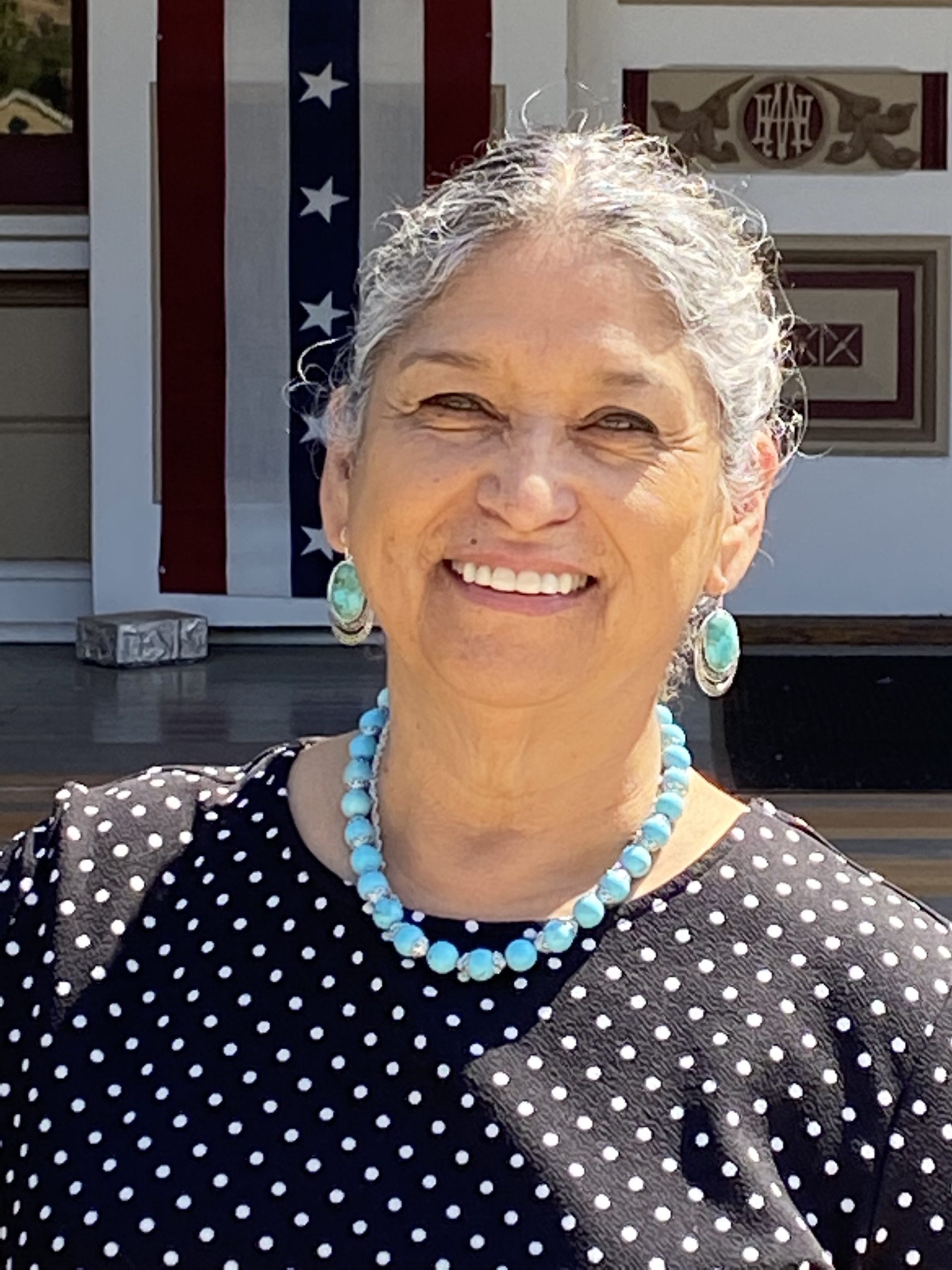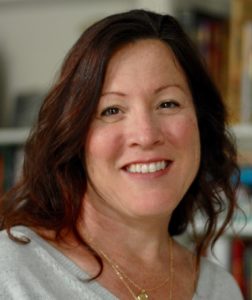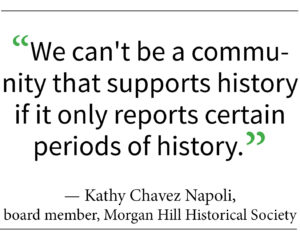Kathy Chavez Napoli has always supported history and was a member of History San Jose.
![]()

Photo courtesy Kathy Chavez Napoli
As a board member of the Morgan Hill Historical Society, Kathy Chavez Napoli looks to promote the history of Native Americans in the South Valley region.
By Kelly Barbazette

Kelly Barbazette
As a board member of the Morgan Hill Historical Society, Kathy Chavez Napoli is committed to ensuring that not just certain segments but the South Valley region’s entire history is represented. She serves as a member of the society’s History Education Committee.
I had the pleasure of speaking to Kathy, 69, recently via Zoom about her work to infuse the community with the culture and history of Latino-Americans and the Amah Mutsun tribe, the most documented Native American tribe in California with a current membership of more than 500 documented Indians.
“More importantly, because I’m a Native American, I really want to share that history with everyone and for the community to recognize that the Native American community has been here longer than everyone. But they’ve been marginalized and made invisible,” Kathy said.
Born in San Jose, Kathy has lived in unincorporated Morgan Hill since 1985. Her roots to the region run deep. She recalls picking grapes along the Monterey Road corridor when it was nicknamed “Blood Alley” because of the large number of traffic accidents. Her children graduated from Live Oak High School.
Her five grandchildren play basketball at the high school’s gym where she and her husband shared their first date in 1970.
Kathy graduated from San Jose State University with a bachelor’s degree in education and a minor in anthropology. She subsequently earned her law degree in her 50s.
She has always supported history and was a member of History San Jose and volunteered at O’Brien’s Ice Cream Parlor and Candy Shop, the oldest soda fountain in the West.
 About eight years ago, she attended a tea hosted by the Morgan Hill Historical Society at the Hiram Morgan Hill House. She noticed that only one room was dedicated to the history of Latinos and the Amah Mutsun tribe.
About eight years ago, she attended a tea hosted by the Morgan Hill Historical Society at the Hiram Morgan Hill House. She noticed that only one room was dedicated to the history of Latinos and the Amah Mutsun tribe.
“We can’t be a community that supports history if it only reports certain periods of history,” she said. She immediately volunteered to be on the historical society board, believing she could bring a point of view that wasn’t being represented.
“The Native American history isn’t a pretty history. It’s a harsh history that needs to be told.”
Kathy recalls when she was about 13 years old learning about a process to compensate Native Americans in California.
She helped her father, who had a third-grade education, collect the necessary documents and paperwork showing their family’s lineage.
“I was struck by the fact that the only people who had to prove who we are are Native Americans,” she said, noting the irony.
 As she grew older, Kathy learned about more inequities that the Native Americans experienced. Her grandmother was sent to a boarding school as a child and wasn’t allowed to learn about her heritage or her native language. Kathy is a member of the federally recognized Susanville Indian Rancheria in Susanville, California.
As she grew older, Kathy learned about more inequities that the Native Americans experienced. Her grandmother was sent to a boarding school as a child and wasn’t allowed to learn about her heritage or her native language. Kathy is a member of the federally recognized Susanville Indian Rancheria in Susanville, California.
When she was a local school teacher, Kathy tried to bring some context to the curriculum about the history of Native Americans in California. Since 2011, third graders have enjoyed field trips to Villa Mira Monte. This was a year after California adopted the Common Core State Standards. With the help of a grant that Kathy applied for, for the past three years (except during the pandemic) between 700 and 900 students have been treated to an hour-long presentation given by Kathy about the Amah Mutsun history and culture.
“It’s been really successful,” she said.
She especially enjoys showing students artifacts, including acorns, abalone shells, and animal pelts, and leading activities, including exploring the genealogy of the students. One homework assignment asks students to find out where their grandparents originated. One year, a group activity revealed that students spoke up to 17 different languages in their households.
 “To me that’s showing living history,” Kathy said.
“To me that’s showing living history,” Kathy said.
When she learned that the county was offering a grant to fund programs acknowledging “untold stories,” Kathy successfully applied for the grant, expanding presentations to Morgan Hill fourth and fifth graders who are studying the California missions and Mexican-American history.
Kathy was also successful in earning grants to hold a youth mariachi competition, which will be held Oct. 2 at the Villa Mira Monte. An event for the Day of the Dead, or Día de los Muertos, a celebration to honor deceased relatives, is set for Oct. 30 and 31 at Villa Mira Monte.
She also has been instrumental in planting a native garden at the Morgan Hill House with plants used by the Amah Mutsun tribe for cleaning, cooking, weaving baskets, and medicinal purposes.
With the help of a grant, the garden will be expanded to include a walkway and placards explaining the historical uses of the plants. Valentin Lopez, chairman of the Amah Mutsun Tribal Band, came to Morgan Hill and taught volunteers about the plants, which include soap plant or soap root. That particular plant had multiple uses. They include washing clothing to fighting poison oak rashes and can be used to make dye when its leaves are boiled. Other plants include sage, gum plants, and mug root.
 Kathy credits Kathy Devine, director of the Morgan Hill Museum, for leadership establishing the historical programs and events.
Kathy credits Kathy Devine, director of the Morgan Hill Museum, for leadership establishing the historical programs and events.
“She’s very supportive of all of these. She works with me. She bounces ideas off me and we present them to the board.”
In her free time, Kathy loves to spend time with her five grandchildren. “They’re my joy along with my sons, and my niece and my nephew.” She’s also a voracious reader.
When asked what advice she would give to other women pursuing their goals, Kathy said to not get discouraged.
“I usually tell people never to give up If they believe in something or believe it’s right,” she said. “They can’t let naysayers put up obstacles.”
Kathy is the first person in her family to graduate from college. Her mother came from a family of 16 children while her father didn’t progress in school past the third grade. Growing up, she had to be strong, develop a thick skin, and be assertive when necessary.
“You just have to keep speaking up — not just for yourself, because if I don’t speak up for us who will?” she said.
Kelly Barbazette
Kelly Barbazette, a former journalist for Bay Area newspapers, is a freelance writer. She lives in Gilroy with her husband and two daughters. She can be reached at [email protected].






